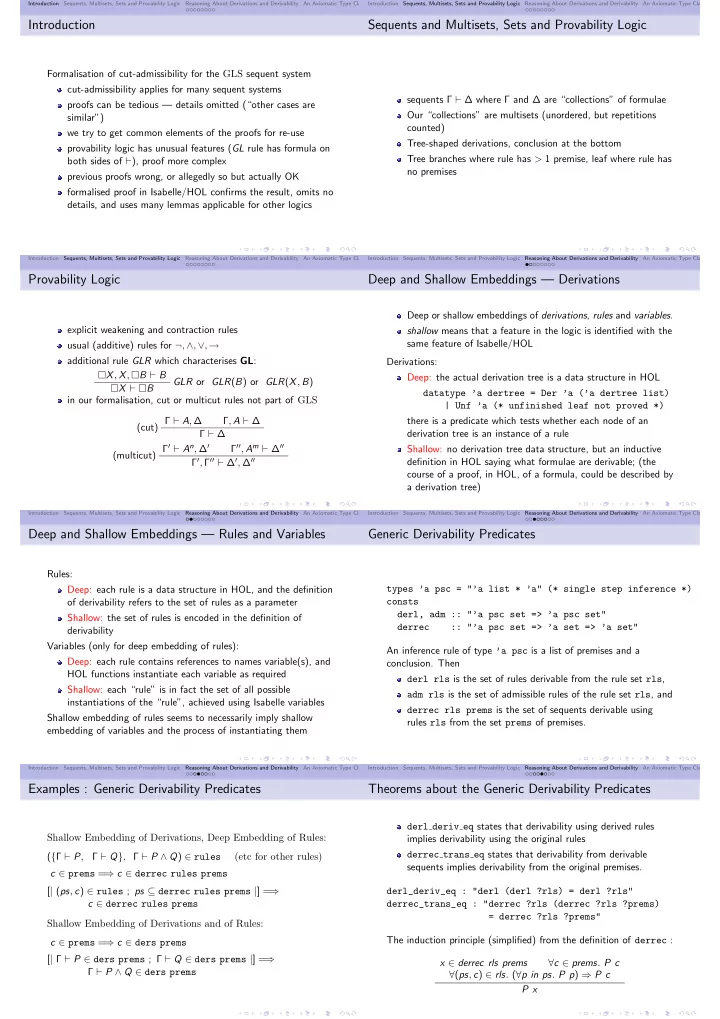

Introduction Sequents, Multisets, Sets and Provability Logic Reasoning About Derivations and Derivability An Axiomatic Type Class Introduction Sequents, Multisets, Sets and Provability Logic Reasoning About Derivations and Derivability An Axiomatic Type Class Introduction Sequents and Multisets, Sets and Provability Logic Formalisation of cut-admissibility for the GLS sequent system cut-admissibility applies for many sequent systems sequents Γ ⊢ ∆ where Γ and ∆ are “collections” of formulae proofs can be tedious — details omitted (“other cases are Our “collections” are multisets (unordered, but repetitions similar”) counted) we try to get common elements of the proofs for re-use Tree-shaped derivations, conclusion at the bottom provability logic has unusual features ( GL rule has formula on Tree branches where rule has > 1 premise, leaf where rule has both sides of ⊢ ), proof more complex no premises previous proofs wrong, or allegedly so but actually OK formalised proof in Isabelle/HOL confirms the result, omits no details, and uses many lemmas applicable for other logics Introduction Sequents, Multisets, Sets and Provability Logic Reasoning About Derivations and Derivability An Axiomatic Type Class Introduction Sequents, Multisets, Sets and Provability Logic Reasoning About Derivations and Derivability An Axiomatic Type Class Provability Logic Deep and Shallow Embeddings — Derivations Deep or shallow embeddings of derivations , rules and variables . explicit weakening and contraction rules shallow means that a feature in the logic is identified with the same feature of Isabelle/HOL usual (additive) rules for ¬ , ∧ , ∨ , → additional rule GLR which characterises GL : Derivations: � X , X , � B ⊢ B GLR or GLR ( B ) or GLR ( X , B ) Deep: the actual derivation tree is a data structure in HOL � X ⊢ � B datatype ’a dertree = Der ’a (’a dertree list) in our formalisation, cut or multicut rules not part of GLS | Unf ’a (* unfinished leaf not proved *) Γ ⊢ A , ∆ Γ , A ⊢ ∆ there is a predicate which tests whether each node of an (cut) derivation tree is an instance of a rule Γ ⊢ ∆ Γ ′ ⊢ A n , ∆ ′ Γ ′′ , A m ⊢ ∆ ′′ Shallow: no derivation tree data structure, but an inductive (multicut) Γ ′ , Γ ′′ ⊢ ∆ ′ , ∆ ′′ definition in HOL saying what formulae are derivable; (the course of a proof, in HOL, of a formula, could be described by a derivation tree) Introduction Sequents, Multisets, Sets and Provability Logic Reasoning About Derivations and Derivability An Axiomatic Type Class Introduction Sequents, Multisets, Sets and Provability Logic Reasoning About Derivations and Derivability An Axiomatic Type Class Deep and Shallow Embeddings — Rules and Variables Generic Derivability Predicates Rules: Deep: each rule is a data structure in HOL, and the definition types ’a psc = "’a list * ’a" (* single step inference *) consts of derivability refers to the set of rules as a parameter derl, adm :: "’a psc set => ’a psc set" Shallow: the set of rules is encoded in the definition of derrec :: "’a psc set => ’a set => ’a set" derivability Variables (only for deep embedding of rules): An inference rule of type ’a psc is a list of premises and a Deep: each rule contains references to names variable(s), and conclusion. Then HOL functions instantiate each variable as required derl rls is the set of rules derivable from the rule set rls , Shallow: each “rule” is in fact the set of all possible adm rls is the set of admissible rules of the rule set rls , and instantiations of the “rule”, achieved using Isabelle variables derrec rls prems is the set of sequents derivable using Shallow embedding of rules seems to necessarily imply shallow rules rls from the set prems of premises. embedding of variables and the process of instantiating them Introduction Sequents, Multisets, Sets and Provability Logic Reasoning About Derivations and Derivability An Axiomatic Type Class Introduction Sequents, Multisets, Sets and Provability Logic Reasoning About Derivations and Derivability An Axiomatic Type Class Examples : Generic Derivability Predicates Theorems about the Generic Derivability Predicates derl deriv eq states that derivability using derived rules Shallow Embedding of Derivations, Deep Embedding of Rules: implies derivability using the original rules derrec trans eq states that derivability from derivable ( { Γ ⊢ P , Γ ⊢ Q } , Γ ⊢ P ∧ Q ) ∈ rules (etc for other rules) sequents implies derivability from the original premises. c ∈ prems = ⇒ c ∈ derrec rules prems [ | ( ps , c ) ∈ rules ; ps ⊆ derrec rules prems | ] = ⇒ derl_deriv_eq : "derl (derl ?rls) = derl ?rls" c ∈ derrec rules prems derrec_trans_eq : "derrec ?rls (derrec ?rls ?prems) = derrec ?rls ?prems" Shallow Embedding of Derivations and of Rules: The induction principle (simplified) from the definition of derrec : c ∈ prems = ⇒ c ∈ ders prems [ | Γ ⊢ P ∈ ders prems ; Γ ⊢ Q ∈ ders prems | ] = ⇒ x ∈ derrec rls prems ∀ c ∈ prems . P c Γ ⊢ P ∧ Q ∈ ders prems ∀ ( ps , c ) ∈ rls . ( ∀ p in ps . P p ) ⇒ P c P x
Recommend
More recommend